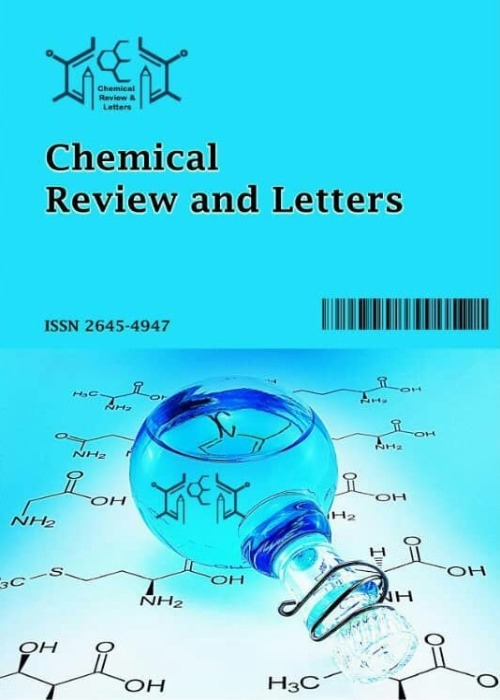فهرست مطالب
Chemical Review and Letters
Volume:1 Issue: 2, Autumn 2018
- تاریخ انتشار: 1397/07/09
- تعداد عناوین: 6
-
Pages 45-48
In this work, the theoretical investigations on the buckyball systems including C20, C24, C26, C28, C30 and C19Si were done to study the structures and properties of different carbon nanoclusters. The geometries of all species were performed at the B3LYP and PBE1PBE levels using the 6-31+G (d) basis set. The HOMO–LUMO energy gap, ionization potential, electron affinity, chemical potential, electronegativity, global hardness and softness, electrophilicity and maximum amount of electronic charge of studied clusters were computed. The results showed that the computed electronic properties were considerable influenced by the size of different carbon nanoclusters. The Si atom doped instead of the carbon atom in C20 was investigated
Keywords: Fullerene, C20-C30, Carbon nanoclusters, HOMO–LUMO energy gap, DFT -
Pages 49-55
Synthesis of organo-telluride compounds through nanoparticles catalyzed C-Te cross-coupling reactions has drawn considerable attention in the past several years. This mini review is an attempt to highlight the most important advances and contributions in this fast-growing research field with the emphasis on the mechanistic aspects of the reactions. The reactions are classified based on the type (e.g. coupling of organic halides with elemental Te(0), coupling of terminal acetylenes with ditellurides). Literature has been surveyed from 2009 to end of 2018
Keywords: Nanocatalysts, C-Te bond, Cross-coupling reactions, Tellurides -
Pages 56-67
This review article is an attempt to highlight the most important contributions toward the synthesis of various nitrogen-containing heterocyclic compounds from corresponding propargylic ureas through regio- and chemoselective 5-exo-dig and 6-endo-dig modes of N- and O-cyclization reactions. The review is divided into three major sections. In the first section we only focus on 5-exo-dig N-cyclization fashion. In the second section 5-exo-dig O-cyclization is described. The third section is devoted to 6-endo-dig N- and O-cyclizations
Keywords: propargylic ureas, 5-exo-dig cyclization, 6-endo-dig cyclization, Heterocyclic compounds -
Pages 68-76
In this study, we report an interesting combined experimental and theoretical studies on the molecular structure of 2-(2,2-bis(3-methoxyphenylthio)ethyl)naphthalene (5). The compound 5 was unexpectedly synthesized and characterized by FT-IR, 1H NMR, 13C NMR, mass spectrum, and elemental analyses. The optimized geometry and mulliken charge density on atoms of 5 were calculated by RM062X and PBE1PBE methods using a 6-31+G(d) basis set. The experimental obtained IR spectra of 5 was compared to the theoretical results at the RM062X/PBE1PBE/6-31+G(d) level which explained in terms of potential energy distribution (PED) analysis. The scaled theoretical vibrational wavenumber displayed very good agreement with experimental data. The calculated proton and carbon chemical shifts show almost a nice correlation with experimental data using RM062X/6-31+G(d) level. Theoretical investigations of frontier molecular orbitals, mapped molecular electrostatic potential (MEP), thermodynamic properties and physico-chemical characteristics of 5, were also acquired
Keywords: Bis(3-methoxyphenylthio)ethyl)naphthalene, Cleavage reaction of epoxide rings, Organosilicon, RM06-2X, PBE1PBE, FT-IR, NMR -
Pages 77-81
NANO MACHINES which are of the capital aims of many advancedresearch projects would contain of complex systems of different devices and actuators that each of them plays a pre-defined role in the overall unit. Nano sensors, nano batteries, nano engines, and nano switches, which contain the most interesting devices for researchers in the related field, are being under consideration for the advance research projects of nano technology. Therefore, in the present project, we have made attempts to reveal the switching behavior of the benzene-C20 fullerene system via a 1,5-sigmatropic shift of the germanium, and silicon-decorated C20 fullerene carbon atoms on the benzene ring. The results showed that in the case of the silicon-decorated C20 fullerene, changingthe system from state A to state Bvia changing the temperature(24.7 kcal mol-1) is much easier than that of germanium-decorated (27.5 kcal mol-1) or normal C20 fullerene (37.8 kcal mol-1). It seems that further studies on this phenomenon, might be beneficial for designing the thermal sensor systems, and energy storage devices
Keywords: Switching behavior, actuator, germanium, silicon-decorated, C20 fullerene -
Pages 82-88
Alcohol with its highly flammable nature to produce CO, and CO2, and also its greenhouse gas emissions, has considerable effects in changing the ecosystem of earth. The high volumes of annual production of this species, as well as its powerful effects on tropospheric changes, have amplified its adverse impacts. Due to these, in this project, by examining the possibility of C20 fullerene (and its nitrogen-boron decorated form (C18NB)) in selective sensing of the low weight straight-chain alcohols (including methanol to n-pentanol), we have attempted to find a new approach for detecting those species. The results show that the C18NB cage senses the existence of methanol (ΔEg= 0.090 eV) better than the C20 fullerene (ΔEg= -0.037 eV). Also, the results indicate that both the C20 fullerene and the C18NB nanocage could sense methanol, clearer and more selective than other mentioned alcohols. Moreover, the results show, that adsorption of methanol by the two mentioned sorbents is thermodynamically more favorable compared to the other alcohols. Also, adsorption of this alcohol by C18NB is significantly favorable than that of C20 fullerene (in view of thermodynamics)
Keywords: Selective sensing, Straight-Chain Alcohols, Uing the C20 Fullerene, C18NB Nano Cage


